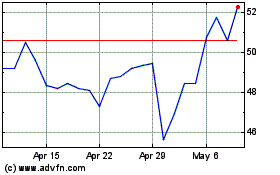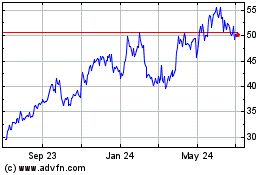Five years ago, meltdowns at the Fukushima Daiichi power plant
in Japan sparked what would become a prolonged slide in prices for
uranium nuclear fuel. Today, the world's worst nuclear disaster in
a quarter-century is depressing prices again.
Antinuclear sentiment is gaining momentum in Japan with the
election three weeks ago of an antinuclear governor in the only
Japanese prefecture with an operating nuclear-power plant, and the
likelihood that a court injunction will halt the next reactor
slated to go online in August.
Japan was once the world's No. 3 nuclear-power generator, behind
the U.S. and France. The slump in the uranium market is being
exacerbated by weak demand from the U.S. and plentiful uranium
supplies in China, an emerging nuclear-power producer.
The price of uranium has slumped to $25 a pound, its lowest
level since April 2005, according to the Ux Consulting Co., a
nuclear-fuel research firmthat publishes weekly market prices. The
fuel's value is down 27% since the start of this year and is a
fraction of the $136 a pound it traded for at its 2007 peak.
It is the worst-performing mined commodity this year. Other
natural resources such as copper, coal and iron ore have gained
year to date.
There is plenty to fret about. In the U.S., a market awash with
cheap natural gas, nuclear reactors have been closing. A few years
ago, France said it would start reducing its reliance on atomic
energy. China, while rolling out a broad expansion of its nuclear
fleet, has built up inventories of uranium that could last more
than a decade.
In Japan, a long-awaited revival hasn't happened.
The Fukushima Daiichi meltdowns in 2011 sparked protests and the
shutdown of its fleet of 50-plus nuclear plants, and tarnished
uranium's image globally. The government had planned to restart
more than 30 reactors by 2030, and analysts had expected as many as
10 back online by 2017.
Now, it isn't certain the two reactors that are operating will
remain running and that the dozens of other reactors not slated for
decommissioning will ever be restarted.
"The restart pace is way behind earlier expectations," said
Jonathan Hinze, international executive vice president at Ux
Consulting. "As long as the Japanese reactors are sitting idle, it
just keeps feeding the negative perceptions in the uranium market
about the demand side."
A court injunction in March forced Kansai Electric Power Co. to
halt its Takahama plant, less than two months after it went online
at the beginning of the year. The court said the utility had failed
to show that the plant would be safe in the event of a quake or
tsunami.
The governor of Kagoshima, Satoshi Mitazono, elected three weeks
ago, has promised voters to suspend operations at the only other
plant in operation, Kyushu Electric Power Co.'s Sendai nuclear
plant. He cited heightened fears among residents following the
April quakes in the Kumamoto area, which had long been thought to
be safe from large tremors.
Residents across Japan are seeking court injunctions to prevent
restarts elsewhere, including a suit to stop the planned August
restart of Shikoku Electric Power Co.'s No.3 reactor at its Ikata
plant.
In 2010, before Japan's mass nuclear-plant closures, the
country's reactors accounted for roughly 12% of uranium demanded by
the global nuclear-energy sector, according to the World Nuclear
Association, an industry group. The U.S. accounted for 28% and
France roughly 15%.
The fate of Japan's sidelined reactors remains an important
driver of market sentiment, producers and analysts say.
Unlike commodities such as copper or oil, the uranium market is
dominated by a small number of mining companies and utilities, and
buyers tend to agree to deals years in advance. That means
expectations for future supply and demand can move prices.
Mr. Hinze said a global glut in U3O8, a common compound of
uranium, is deepening. Annual supplies of about 200 million pounds
are well above the 170 million pounds needed each year to feed the
world's operating reactors. Stockpiles have climbed from virtually
nothing before the Fukushima disaster to more than 1.4 billion
pounds now, Mr. Hinze estimated.
In the U.S., five reactors have shut since 2013, and over the
past year or so, an additional seven reactors in the U.S. have been
slated to close early.
Ux Consulting said China already has about 300 million pounds of
U3O8 stockpiled, enough to last it years even as it ramps up
production of nuclear power.
Uranium producers remain upbeat on the eventual prospects for
uranium as emerging economies build up their power
infrastructure.
China has stepped up efforts to introduce cleaner energy and has
the world's largest pipeline of nuclear-power plants. More than 30
reactors have been built in China since the 1990s. There are now
another 20 under construction in China, according to the
International Atomic Energy Agency.
Nuclear-power generation increased by 1.3% in 2015, underpinned
by a roughly 30% increase in China's output, according to a World
Nuclear Industry Status Report. Still, annual nuclear electricity
generation, at 2,441 net terawatt-hours, was 8.2% below 2006
levels.
"Despite the current market challenges, we remain confident in
nuclear power," Canada's Cameco Corp. said Thursday as it reported
a quarterly net loss. Cameco is the world's No. 2 uranium mining
company by market share, behind Kazakhstan state-owned NAC
Kazatomprom JSC. Shares in Cameco are down about 26% in 2016.
Capital Economics anticipates more new plants will spur a
recovery to $35 a pound by the end of 2016 and to $40 a pound by
the end of next year.
Others remain cautious. Macquarie said in a July 26 note that it
"is increasingly difficult to see what drives uranium materially
higher from here."
Mr. Hinze said one of the main sources of demand now is from
traders who are buying low-cost material for longer-run deals with
utilities.
"We call this 'demand stealing from the future'," he said, "as
it's basically a way of moving future demand into the present."
Write to Rhiannon Hoyle at rhiannon.hoyle@wsj.com and Mayumi
Negishi at mayumi.negishi@wsj.com
(END) Dow Jones Newswires
July 31, 2016 22:55 ET (02:55 GMT)
Copyright (c) 2016 Dow Jones & Company, Inc.
Cameco (NYSE:CCJ)
Historical Stock Chart
From Mar 2024 to Apr 2024

Cameco (NYSE:CCJ)
Historical Stock Chart
From Apr 2023 to Apr 2024
